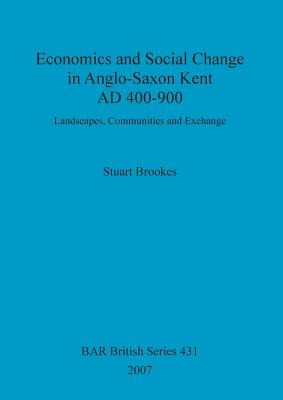
- We will send in 10–14 business days.
- Author: Stuart Brookes
- Publisher: British Archaeological Reports Oxford Ltd
- ISBN-10: 1407300164
- ISBN-13: 9781407300160
- Format: 21 x 29.7 x 1.8 cm, softcover
- Language: English
- SAVE -10% with code: EXTRA
Economics and Social Change in Anglo-Saxon Kent AD 400-900 (e-book) (used book) | bookbook.eu
Reviews
Description
This book examines archaeological and historical evidence for the socio-economic organization of the kingdom of East Kent, England, as a territorial and social system during the Early to Middle Anglo-Saxon period (AD 400-900). Explicit archaeological and theoretical frameworks are considered to propose a hierarchical model of the spatial organization of communities as a way of providing a micro-economic case study of state formation. In addition to other classical economic and geographical analyses applied, the distributional approach examines the frequency or quantity of commodities with respect to units of economic consumption, such as individuals, households and communities. By examining the saturation levels of community consumption as represented in burial assemblages, a hierarchical model of value regimes underlying exchange sub-systems is suggested. Taken in combination with an analysis of the geographical organisation of settlement, the author argues a thesis on the way regional space was socially and spatially constructed in ways that restricted and monopolised allocative and authoritative resources. Correlations between spatially-distributed phenomena and features of the physical environment are assessed in order to consider the social dynamic in land-holding underlying the territorial and spatially-definable conditions of reproduction. An assessment is made of the importance of restrictions on the movement of people in social formation, by analysing the relationships between routes of communication, the mortuary landscape, and the visual experience of movement. Finally, consideration of these phenomena with respect to changing exchange systems provides models of early medieval state formation.
EXTRA 10 % discount with code: EXTRA
The promotion ends in 17d.21:44:14
The discount code is valid when purchasing from 10 €. Discounts do not stack.
- Author: Stuart Brookes
- Publisher: British Archaeological Reports Oxford Ltd
- ISBN-10: 1407300164
- ISBN-13: 9781407300160
- Format: 21 x 29.7 x 1.8 cm, softcover
- Language: English English
This book examines archaeological and historical evidence for the socio-economic organization of the kingdom of East Kent, England, as a territorial and social system during the Early to Middle Anglo-Saxon period (AD 400-900). Explicit archaeological and theoretical frameworks are considered to propose a hierarchical model of the spatial organization of communities as a way of providing a micro-economic case study of state formation. In addition to other classical economic and geographical analyses applied, the distributional approach examines the frequency or quantity of commodities with respect to units of economic consumption, such as individuals, households and communities. By examining the saturation levels of community consumption as represented in burial assemblages, a hierarchical model of value regimes underlying exchange sub-systems is suggested. Taken in combination with an analysis of the geographical organisation of settlement, the author argues a thesis on the way regional space was socially and spatially constructed in ways that restricted and monopolised allocative and authoritative resources. Correlations between spatially-distributed phenomena and features of the physical environment are assessed in order to consider the social dynamic in land-holding underlying the territorial and spatially-definable conditions of reproduction. An assessment is made of the importance of restrictions on the movement of people in social formation, by analysing the relationships between routes of communication, the mortuary landscape, and the visual experience of movement. Finally, consideration of these phenomena with respect to changing exchange systems provides models of early medieval state formation.


Reviews